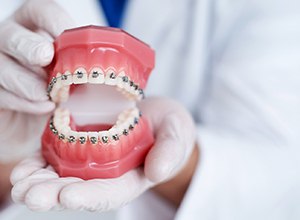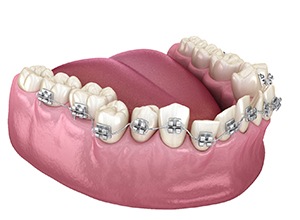
If you would like to straighten your teeth, you have several treatment options. One of the most popular and effective ways to address dental misalignment is traditional braces in Meriden. This tried-and-true method for straightening teeth has already helped generations of patients to enjoy improved oral health — it may be able to help you as well. Continue reading below to learn more about braces, and get in touch with us when you are ready to schedule your orthodontic consultation.
Why Choose Meriden Dental Group for Traditional Braces?
- Warm and Welcoming Environment
- Weekend Appointments Available
- Flexible Payment Options
How Do Traditional Braces Work?

When you first get braces, brackets will be bonded onto your teeth. An arch wire will connect those brackets. At periodic appointments (every 6 – 8 weeks or so), the wire will be adjusted so the braces will continue to apply pressure to your teeth, gradually shifting them into their proper positions. In most cases, braces complete their work in 18 – 36 months. Once you finish treatment, you can expect to have a healthier, more attractive smile.
What Orthodontic Issues Can Braces Fix?

During your consultation, we will determine if traditional braces are a fit for your circumstances. They are suitable for most patients with mild to severe dental misalignment. Here are some examples of issues they are commonly able to address:
Bite Misalignment
Problems like overbite, underbite, crossbite, and open bite can interfere with your facial aesthetics, endanger your oral health, and contribute to problems with your TMJ. Braces, usually with the help of other accessories, such as elastics, can fix most cases of bite misalignment.
Crowded & Crooked Teeth
Crooked and crowded teeth are prone to trap food between them, increasing your risk of bad breath, tooth decay, and gum disease. Braces can usually move the teeth in a way that gives each one the space it needs to function optimally. In some cases, extractions can aid in this process.
Gapped Teeth
Noticeable gaps between the teeth are generally viewed as unsightly. Plus, they can leave the gums vulnerable to harm. Braces are often able to move the teeth closer together, resulting in a more attractive smile that is at a lower risk of future problems.
Caring for Your Braces

Here are some tips for taking good care of your braces and your teeth throughout your treatment:
- Be diligent about oral hygiene. You may have to brush and floss more often than you are used to. You may also have to adapt to using special tools to clean around your braces.
- Adjust your diet. Sticky and hard foods can damage your braces or get stuck in them. You should adhere to all dietary restrictions that your dentist in Meriden recommends.
- Attend all recommended appointments. In addition to coming in for orthodontic checkups, you should also attend regular exams and cleanings to keep your teeth in great shape.
